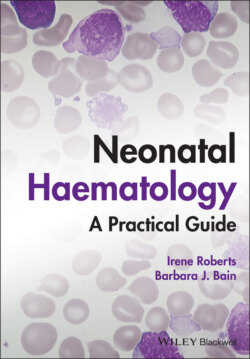Читать книгу Neonatal Haematology - Barbara J. Bain, Irene Roberts - Страница 41
Gestational age and postnatal age
ОглавлениеAlthough the Hb, haematocrit and MCV vary little over the first week of life, there is a gradual loss of other distinctive neonatal red cell features after the first week of life. In particular, the numbers of circulating nucleated red cells fall, as mentioned above, and echinocytes are gradually replaced by red cells with the more typical appearance of adult red cells. Consideration of the postnatal age of a baby is most important when interpreting blood films to help in the identification of infection or the cause of anaemia. For example, maternal chorioamnionitis may cause extremely high neutrophil counts, often with associated toxic granulation, in the newborn infant despite the absence of active infection in the neonate (Fig. 1.19). It seems likely that this is due to maternal cytokines crossing the placenta, although this has not been specifically demonstrated. Importantly, virtually identical changes observed on neonatal blood films after the first week of life are highly likely to reflect active infection in the neonate as any maternal cytokine‐driven changes will have resolved by this time.
Fig. 1.19 Blood film in maternal chorioamnionitis showing neutrophilia, left shift (myelocytes and promyelocytes) and toxic granulation. MGG, ×40.
Fig. 1.20 Leucoerythroblastic blood film in a preterm neonate with hypoxic ischaemic encephalopathy showing a myelocyte, an NRBC, an eosinophil and a macropolycyte, likely to be a tetraploid cell. MGG, ×100.
